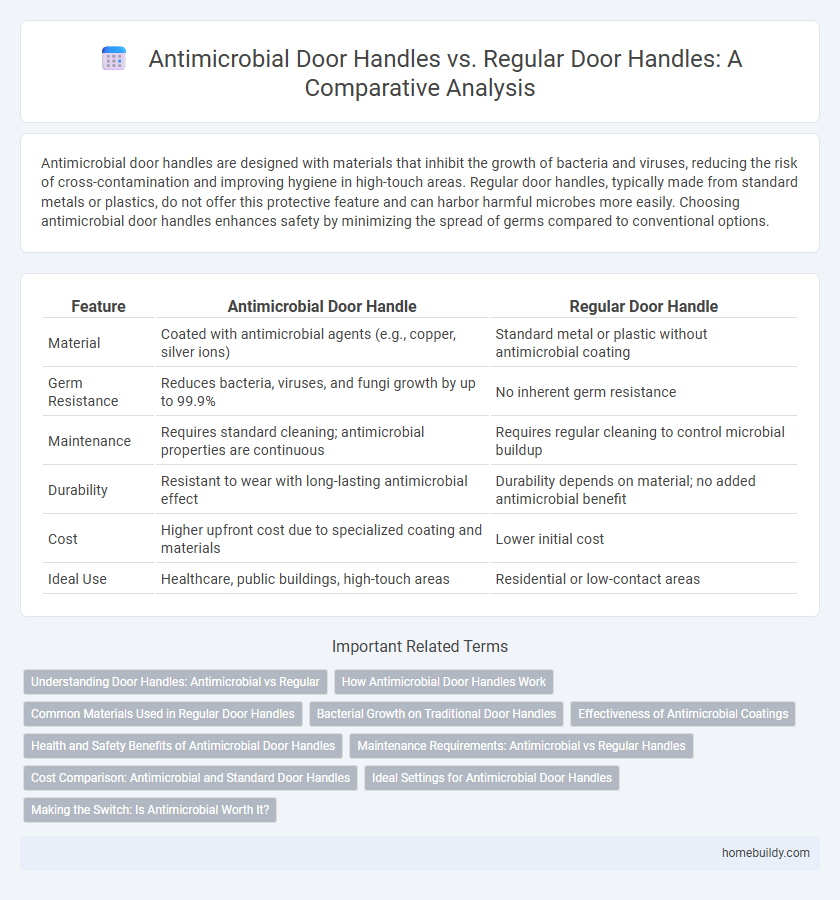Antimicrobial door handles are designed with materials that inhibit the growth of bacteria and viruses, reducing the risk of cross-contamination and improving hygiene in high-touch areas. Regular door handles, typically made from standard metals or plastics, do not offer this protective feature and can harbor harmful microbes more easily. Choosing antimicrobial door handles enhances safety by minimizing the spread of germs compared to conventional options.
Table of Comparison
| Feature | Antimicrobial Door Handle | Regular Door Handle |
|---|---|---|
| Material | Coated with antimicrobial agents (e.g., copper, silver ions) | Standard metal or plastic without antimicrobial coating |
| Germ Resistance | Reduces bacteria, viruses, and fungi growth by up to 99.9% | No inherent germ resistance |
| Maintenance | Requires standard cleaning; antimicrobial properties are continuous | Requires regular cleaning to control microbial buildup |
| Durability | Resistant to wear with long-lasting antimicrobial effect | Durability depends on material; no added antimicrobial benefit |
| Cost | Higher upfront cost due to specialized coating and materials | Lower initial cost |
| Ideal Use | Healthcare, public buildings, high-touch areas | Residential or low-contact areas |
Understanding Door Handles: Antimicrobial vs Regular
Antimicrobial door handles incorporate materials like copper or silver ions that actively inhibit the growth of bacteria and viruses, reducing the risk of surface contamination. Regular door handles, typically made of stainless steel, aluminum, or plastic, lack inherent germ-killing properties and may require frequent cleaning to maintain hygiene. Choosing antimicrobial options enhances public health safety, especially in high-traffic or healthcare environments, by minimizing pathogen transmission through contact surfaces.
How Antimicrobial Door Handles Work
Antimicrobial door handles utilize surfaces coated with materials like copper, silver ions, or specialized polymers that actively kill or inhibit the growth of bacteria, viruses, and fungi upon contact. These coatings disrupt microbial cell membranes or interfere with vital biological processes, reducing the risk of pathogen transmission compared to regular door handles. By continuously neutralizing germs on their surface, antimicrobial door handles enhance hygiene in high-traffic environments such as hospitals, schools, and public facilities.
Common Materials Used in Regular Door Handles
Common materials used in regular door handles include stainless steel, brass, aluminum, and zinc alloy, each offering varying levels of durability and corrosion resistance. Stainless steel door handles are popular for their strength and ease of maintenance, while brass handles naturally exhibit some antimicrobial properties but may tarnish over time. Aluminum and zinc alloy handles are cost-effective choices but typically lack inherent antimicrobial features, making them more susceptible to bacterial buildup compared to specialized antimicrobial handles.
Bacterial Growth on Traditional Door Handles
Traditional door handles often harbor significant bacterial growth due to frequent contact and lack of antimicrobial properties, leading to potential health risks. Studies indicate that common pathogens such as Staphylococcus aureus and E. coli can survive on these surfaces for days, increasing the likelihood of cross-contamination. In contrast, antimicrobial door handles incorporate materials or coatings that inhibit bacterial proliferation, effectively reducing the presence of harmful microbes.
Effectiveness of Antimicrobial Coatings
Antimicrobial coatings on door handles significantly reduce bacterial and viral contamination, decreasing the transmission of pathogens compared to regular door handles. Studies show these coatings can kill up to 99.9% of harmful microbes within hours, enhancing hygiene in high-traffic areas such as hospitals and public buildings. Regular door handles lack this protective feature, allowing germs to accumulate and increasing the risk of cross-contamination.
Health and Safety Benefits of Antimicrobial Door Handles
Antimicrobial door handles significantly reduce the presence of harmful bacteria and viruses on frequently touched surfaces, decreasing the risk of cross-contamination and infections in public and healthcare environments. These handles use materials or coatings with proven antimicrobial properties, such as copper alloys or silver ions, to continuously inhibit microbial growth. Choosing antimicrobial door handles enhances health and safety by promoting a cleaner environment and reducing the spread of illnesses.
Maintenance Requirements: Antimicrobial vs Regular Handles
Antimicrobial door handles require less frequent cleaning and disinfecting due to their built-in surface protection that inhibits microbial growth, reducing the risk of contamination. Regular door handles demand more rigorous and frequent maintenance to effectively eliminate bacteria and viruses, increasing labor and cleaning costs. Choosing antimicrobial handles optimizes hygiene management by minimizing maintenance efforts while sustaining high sanitation standards.
Cost Comparison: Antimicrobial and Standard Door Handles
Antimicrobial door handles typically have a higher upfront cost compared to standard door handles due to the inclusion of metals like copper or silver that inhibit microbial growth. Over time, antimicrobial handles may reduce cleaning and maintenance expenses, potentially offsetting the initial investment through decreased need for disinfectants. Standard door handles are usually less expensive initially but may incur higher long-term costs associated with frequent cleaning and replacement in high-traffic or hygiene-sensitive environments.
Ideal Settings for Antimicrobial Door Handles
Antimicrobial door handles are ideal for high-traffic and hygiene-sensitive environments such as hospitals, schools, and food processing facilities where reducing pathogen transmission is critical. Unlike regular door handles, they incorporate materials like copper alloys or coatings with antimicrobial properties that continuously inhibit bacterial and viral growth. These features make antimicrobial door handles essential in settings requiring stringent infection control and enhanced durability.
Making the Switch: Is Antimicrobial Worth It?
Antimicrobial door handles reduce the presence of harmful bacteria and viruses by using surfaces treated with agents like silver ions or copper alloys, which actively inhibit microbial growth. Compared to regular door handles, they offer enhanced hygiene by lowering the risk of cross-contamination in high-traffic areas such as hospitals, offices, and public buildings. Investing in antimicrobial door handles can lead to decreased cleaning frequency and improved public health safety, making the switch a valuable upgrade for environments prioritizing infection control.
antimicrobial door handle vs regular door handle Infographic

 homebuildy.com
homebuildy.com